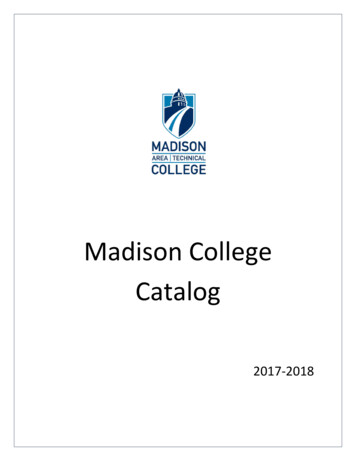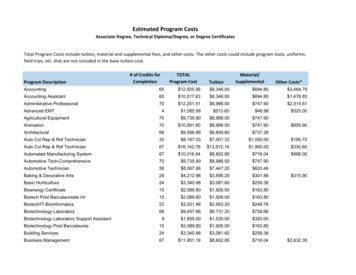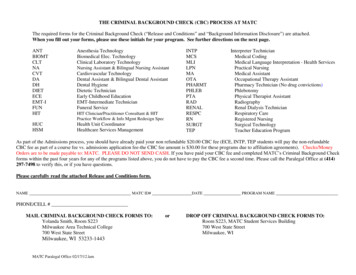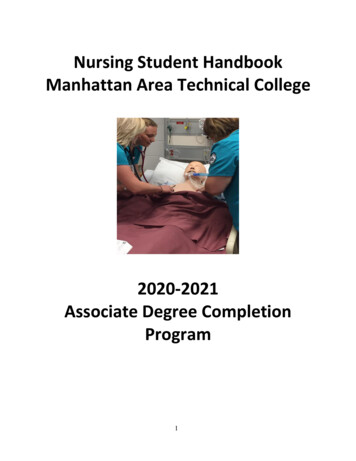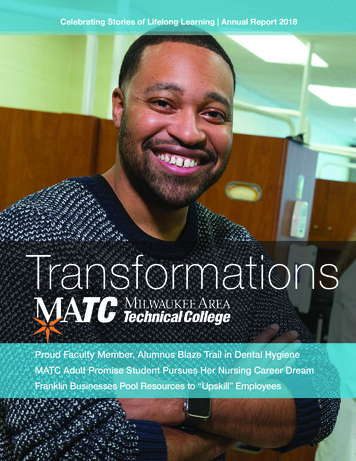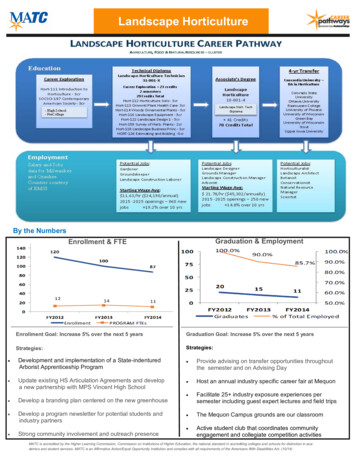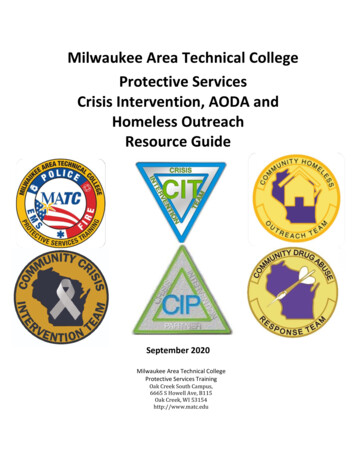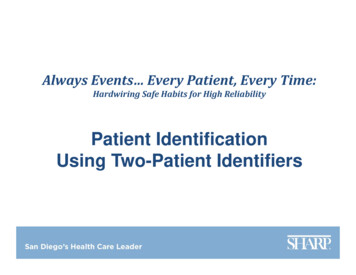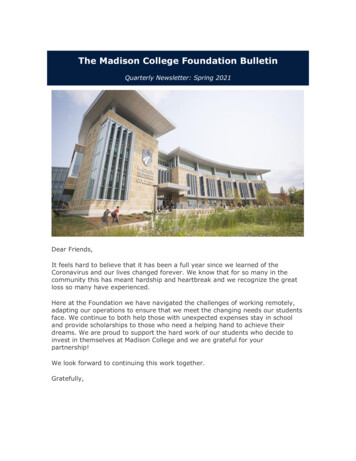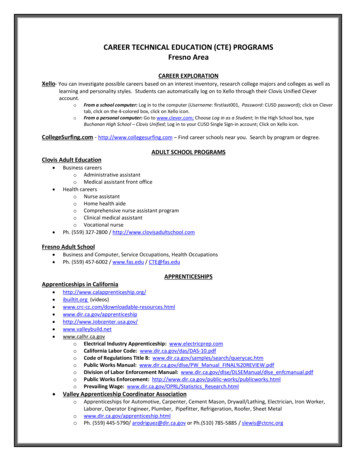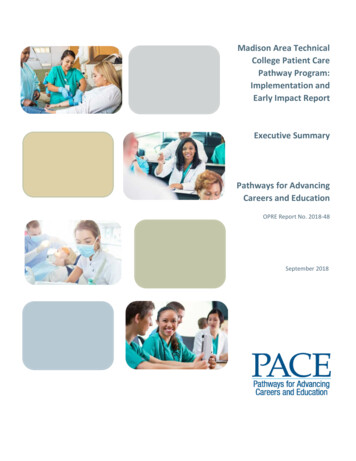
Transcription
Madison Area TechnicalCollege Patient CarePathway Program:Implementation andEarly Impact ReportExecutive SummaryPathways for AdvancingCareers and EducationOPRE Report No. 2018-48September 2018
Madison Area Technical College Patient Care PathwayProgram: Implementation and Early Impact ReportPathways for Advancing Careers and Education (PACE)OPRE Report No. 2018-48September 2018Rachel Cook, Jill Hamadyk, Matthew Zeidenberg, Howard Rolston, and Karen Gardiner, Abt AssociatesSubmitted to:Nicole ConstanceFederal Project OfficerOffice of Planning, Research, and EvaluationAdministration for Children and FamiliesU.S. Department of Health and Human ServicesContract No. HHSP2332007913YCProject Director: Karen GardinerAbt Associates Inc.6130 Executive BoulevardRockville, MD 20852This report is in the public domain. Permission to reproduce is not necessary. Suggested citation: Cook, R.,Hamadyk, J., Zeidenberg, M., Rolston, H., and K. Gardiner. (2018). Madison Area Technical College Patient CarePathway: Implementation and Early Impact Report, OPRE Report # 2018-48, Washington, DC: Office of Planning,Research, and Evaluation, Administration for Children and Families, U.S. Department of Health and HumanServices.DisclaimerThe views expressed in this publication do not necessarily reflect the views or policies of the Office of Planning,Research, and Evaluation, the Administration for Children and Families, or the U.S. Department of Health andHuman Services.This report and other reports sponsored by the Office of Planning, Research, and Evaluation are available Sign-up for theACF OPRE News ENewsletterLike OPRE on Facebookfacebook.com/OPRE.ACFFollow OPRE onTwitter @OPRE ACF
Madison Area Technical College Patient Care Pathway ProgramImplementation and Early Impact ReportPACEExecutive SummaryOver the next 10 years, the federal government projects that demand for workers in healthcarejobs will grow quickly as the population grows and ages. 1 Successfully meeting the need formore healthcare workers is important both to the national economy and to the quality ofhealthcare available to the population. This demand also creates opportunities for low-incomeadults’ entry-level employment and advancement to higher-skilled jobs. Almost all jobs inhealthcare require some level of training after high school. Policymakers, workforcedevelopment organizations, educators, and other key stakeholders are very interested in howto enable the match between the nation’s need for a skilled workforce and low-income adults’need for employment.Patient Care Pathway ProgramThis report provides early evidence on the implementation and impacts of the Patient CarePathway program, operated between 2011 and 2014 by Madison Area Technical College(hereafter referred to as Madison College), a community college in the Madison, Wisconsin,area. The program aimed to help low-skilled studentsQuick Evaluation Findingsaccess occupational training in the growing The program implemented mosthealthcare sector. Through the Patient Care Pathwaycomponents as planned, with somemodifications. The exception was theprogram, Madison College combined occupationaladvising component, which was lesscourses, contextualized basic skills courses, andintensive than planned.advising into semester-long “academies.” The goal Healthcare program admissionpolicies at Madison College createdwas to promote persistence toward and completionbarriers for admission to and timelyof college-level healthcare diploma and degreecompletion of diploma and degreeprograms.programs. Over an 18-month follow-up period,The Patient Care Pathway program adapted andcompared with control groupmembers, treatment group membersconnected existing one-semester programs to create(those with access to the Patientthree Patient Care Pathway academies. The purposeCare Pathway program): did not earn more college credits;of the academies was to give students with low test did not earn more credentials;scores (ACT Compass ) an accelerated pathway into were seven percentage pointsthe healthcare training program of their choice.more likely to be enrolled inPatient Care Academy 1 (PCA1) targeted studentsoccupational training; and did not participate in more hours ofinterested in a one-year healthcare diploma; Patientoccupational training.Care Academy 2 (PCA2) targeted students interestedin pursuing a two-year associate’s degree inhealthcare. PCA1 was also the starting point for students interested in a two-year degree1Bureau of Labor Statistics, U.S. Department of Labor. 2015. “Employment Projections: 2014-24 Summary.”Press Release. Accessed September 1, 2016, http://www.bls.gov/news.release/ecopro.nr0.htm.Abt AssociatesExecutive Summary pg. iii
Madison Area Technical College Patient Care Pathway ProgramImplementation and Early Impact ReportPACEprogram, but who did not have the required basic skills to be eligible for PCA2. After completingPCA1, students who successfully met the required test scores could enroll in a one-yearhealthcare diploma program or continue to PCA2. At the outset of the study, students whocompleted PCA2 were qualified to enroll in one of the college’s two-year healthcare degreeprograms without retesting, though that later changed. The Patient Care Pathway programadded a third academy, Patient Care Nursing Assistant (PCNA), in 2013, after the study hadstarted. Students who successfully completed PCNA could transition to PCA1 or (if they had therequired basic skills) PCA2, or seek employment.Patient Care Pathway academies. The Patient Care Pathway academies had the followingcharacteristics: Sectoral bridge program. Programs that package occupational training and remediationof basic skills to prepare students for a specific occupational field are described assectoral bridge programs. Each academy provided such a set of basic and occupationalskills courses delivered over a semester. Sequenced training steps. By packaging specific sets of courses in each academy, thePatient Care Pathway program created a clear pathway to enrollment in healthcarediploma or degree programs. Acceleration. The goal of the academies was to accelerate students’ entry into thecollege’s healthcare programs by shortening the time spent on remediation for studentswhose reading, writing, and math skills were too low to gain admission directly. In theabsence of the academies, students would have to improve their basic skills first bycompleting up to three semesters of coursework in the college’s developmentaleducation sequence. In comparison, the academies paired basic skills and occupationalcoursework in one semester. Contextualization. The academies contextualized specific basic skills courses byintegrating occupational content into their curricula.Advising. The Patient Care Pathway program advisors aimed to meet with assigned students atleast three times during a semester. Their role was to work with students to navigate thecollege system and program admission process, develop an academic plan, and identify andaddress academic and non-academic barriers. The advisors could do this by helping studentsaccess services available at Madison College and in the community and by using an emergencyfund to assist them with small, short-term financial needs.Pathways for Advancing Careers and Education (PACE) EvaluationAbt Associates and its partners are evaluating the Patient Care Pathway program as part of thePathways for Advancing Careers and Education (PACE) evaluation. Funded by theAdministration for Children and Families (ACF) within the U.S. Department of Health andAbt AssociatesExecutive Summary pg. iv
Madison Area Technical College Patient Care Pathway ProgramImplementation and Early Impact ReportPACEHuman Services, PACE is an evaluation of nine programs that include key features of a “careerpathways framework.”The career pathways framework guides the development and operation of programs aiming toimprove the occupational skills of low-income adults by increasing their entry into, persistencein, and completion of postsecondary training. These students are primarily older andnontraditional. The framework describes strategies for overcoming barriers to education andtraining that these students can face. Key features of this framework include: a series of well-defined training steps; promising instructional approaches targeted to adult learners; services to address academic and non-academic barriers to program enrollment andcompletion; and connections to employment.The Patient Care Pathway program evaluation comprises two components: An implementationstudy examined the design and operation of the program and enrolled students’ participationpatterns. An impact study used an experimental design to measure differences in educationaland employment outcomes between students randomly assigned to a group that could accessthe Patient Care Pathway program (treatment group) and a group that could not (controlgroup). Using data from baseline surveys, a follow-up survey, Madison College records, and sitevisits, this report provides the results from the implementation study and describes the earlyimpacts of the program (18 months after random assignment) on education and training. 2Key FindingsThis summary documents findings from the implementation study and early findings (18months after random assignment) from the impact study, including the number of collegecredits students earned— the confirmatory outcome used to assess the early effects of thePatient Care Pathway program.Implementation StudyThe implementation study examined how planned Patient Care Pathway program instructionand supportive services were implemented, patterns of engagement in the program by its2The analysis plan is on the ACF website: on-design-impact-analysis-plan. Outcomes were also registered onthe What Works Clearinghouse (WWC) and Open Science Framework (OSF) sites. The analysis plan was postedto the WWC online registry of randomized control trials (RCT) on May 20, 2016. In September 2016, under theterms of a grant from the Institute of Education Sciences, the RCT registry information was removed from theWWC website and transferred to the Society for Research on Educational Effectiveness (SREE). SREE plans tore-launch the registry in late 2018, at which time the analysis plan will be available in a searchable onlinedatabase. Registration on the OSF website can be found at https://osf.io/q5weg/.Abt AssociatesExecutive Summary pg. v
Madison Area Technical College Patient Care Pathway ProgramImplementation and Early Impact ReportPACEstudents, and receipt of education and training and services by the treatment group membersrelative to the control group. Key findings from the implementation study are summarized inExhibit ES-1 and described in detail below.Exhibit ES-1. Summary of Key Findings from the Patient Care Pathway Program ImplementationStudyEvaluation QuestionConclusionWas the program implemented with fidelity tothe design?The Patient Care Pathway program implemented most components asplanned, including the training and instructional approaches, with some smallmodifications.How did the program deviate from thedesign?The program had recruitment challenges and enrolled just half of theplanned study sample. Thus, the program operated at a smaller scale thanplanned, resulting in a small study sample and larger sampling errors, whichmakes it harder to detect moderate-sized impacts. The program added twoinstructional supports (a supplemental instructor and group tutoringsessions) intended to increase students’ academic success. The advisingcomponent was less intensive than planned.Control group members received more guidance on course selection andregistration than planned—a deviation from the study protocol that lessenedthe service contrast. The program manager provided this additional guidancein one-on-one intake sessions for an estimated 50 percent of control groupmembers. However, the study team found low levels of enrollment inrecommended courses in the semester after random assignment, suggestingthat any effects of this additional guidance would likely be small.Were there gaps or omissions in the programdesign?The program aimed to move students into healthcare diploma and degreeprograms quickly by shortening the time required to raise basic skills levels,but it did not address other barriers at Madison College that delayedadmission to and completion of healthcare programs.Specific college policies that created barriers to timely program admissionincluded short and infrequent application windows, lags of up to a yearbetween an application window and program admission and start dates, andthe adoption of the Test of Essential Academic Skills (TEAS) assessment asan admission requirement partway through the random assignment period.Even after successfully gaining admission to a healthcare program, studentsoften faced long waitlists that delayed them enrolling in core courses, whichslowed their progress toward diploma or degree completion.What were students’ participation patternsand experiences with program services?The majority of treatment group members (91 percent) participated in at leastone of the Patient Care Pathway academies. Completion rates for theacademies were high: 50 percent for PCNA, 81 percent for PCA1, and 78percent for PCA2. However, less than a quarter of treatment group membersearned a credential within the 18-month follow-up period. During the samefollow-up period, only seven percent of all treatment group members gainedadmission to one of the healthcare programs targeted by PCA1 or PCA2.The majority of treatment group members were still enrolled in courses at theend of the follow-up period.The Patient Care Pathway program did not have a statistically significantimpact on receipt of any education or training.Abt AssociatesExecutive Summary pg. vi
Madison Area Technical College Patient Care Pathway ProgramImplementation and Early Impact ReportPACE Recruitment challenges led the Patient Care Pathway program to operate at a smallerscale than expected.Throughout the study period, program staff struggled to recruit enough students to meet theevaluation’s sample goals. Staff implemented strategies to increase enrollment in the program,including adding a full-time recruiter, working with a technical assistance provider, and addingPCNA to the pathway. However, at the end of the random assignment period, the program hadrecruited just 500 study participants—half of the target sample of 1,000. The Patient Care Pathway program delivered training largely as designed.The program contextualized specific basic skills courses in PCA1 and PCA2 for the healthcarefield as planned. In its instructional approaches, the program aimed to emphasize activelearning (e.g., group work and problem-solving tasks) and use technology to supplement inclass instruction. The program implemented these instructional approaches when possible, butinstructors reported that some courses necessitated a traditional, lecture-based format.During the first year of the study, the program added two instructional supports intended toincrease students’ academic success. In response to PCA2 students’ difficulties with theChemistry class, staff added a supplemental instructor who attended the class, took notes toshare with students with learning disabilities who needed academic accommodations, andfacilitated an optional review session each week. The program advisor also organized grouptutoring for PCA1 students who needed or wanted additional instructional support. Finally,after Madison College implemented the Test of Essential Academic Skills (TEAS) assessment forthose two-year healthcare program applicants, program staff added a TEAS workshop to helpstudents prepare for it. The Patient Care Pathway program’s advising was less intensive than planned, thoughmost treatment group members received advising at least once.The program advisors aimed to meet one-on-one with the students assigned to them at leastthree times over the semester to monitor progress and address any needs. The program had ablueprint for each advising session. The initial session covered financial aid, academic and nonacademic barriers to school, and course requirements. The mid-semester session focused onacademic plan development. The end-of-semester session focused on academic plans andregistration for the next semester’s courses.According to the participant follow-up survey, the majority of students who enrolled in trainingstated they received academic advising at least once (70 percent). Fewer than half (45 percent)reported receiving academic advising three or more times (i.e., the recommended minimumnumber of advising sessions). Students who enrolled earlier were more likely to reportreceiving three sessions of academic advising than were students who enrolled later(51 percent versus 32 percent). Many program participants reported receiving other types ofAbt AssociatesExecutive Summary pg. vii
Madison Area Technical College Patient Care Pathway ProgramImplementation and Early Impact ReportPACEservices, such as financial aid advising and help arranging supports for work or school. Whileadvising was less intensive than planned, Patient Care Pathway students who received anyeducation or training were more likely to receive advising. For the subset of treatment andcontrol group members who reported enrolling in education or training, significantly moretreatment group members ever received academic advising supports (70 percent comparedwith 55 percent of control group members) and received academic advising three or moretimes (45 percent compared with 35 percent of control group members). Control group members received more assistance with course selection and registrationthan planned.After the study period concluded, the evaluation team learned of a deviation from studyprocedures. Specifically, during one-on-one intake sessions the program manager providedpotential study participants with specific course recommendations before random assignment.The program manager reported providing this guidance because potential study participantshad detailed questions prior to random assignment about the control group pathway and howit compared to the Patient Care Pathway program available to the treatment group. She alsosaw this as a helpful way of marketing the program. In addition, the program manager providedsome control group members assistance with registering for classes after random assignment.The additional guidance and assistance enrolling in courses was provided to an estimated 50percent of those ultimately assigned the control group, thus lessening the service contrastbetween the treatment and control groups. However, the study team examined enrollmentdata for the semester after random assignment and found that less than 15 percent of controlgroup members enrolled in any of the recommended courses. This low rate suggests that theprovision of guidance prior to random assignment and assistance registering control groupmembers following random assignment is likely to have at most a small negative effect onimpact estimates of educational outcomes. Given that the study population was largelyrecruited within the college, some proportion would have enrolled in courses even without theadditional support. Healthcare program admission policies at Madison College created barriers for PatientCare Pathway academy completers to transition to and complete destination programs.The academies aimed to facilitate quick admission to and enrollment in “destination”healthcare diploma and degree programs by shortening the time necessary to raise students’basic skills and meet admission requirements. However, during the study period, four factorsnot addressed in the design created barri
Madison Area Technical College Patient Care Pathway Program Implementation and Early Impact Report PACE Abt Associates Executive Summary pg. iv program, but who did not have the required basic skills to be eligible for PCA2. After completing PCA1, students who successfull
